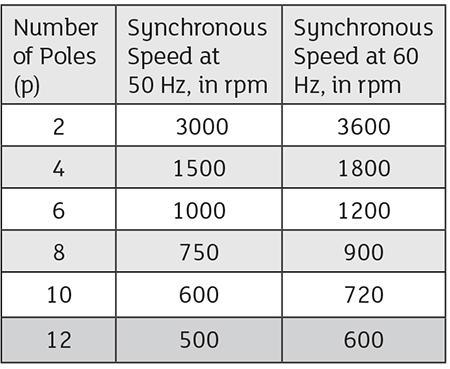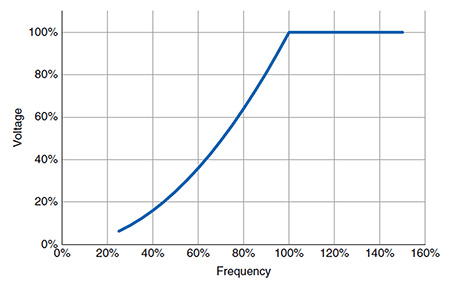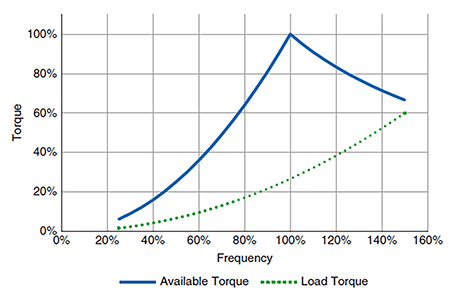
In some instances, operating a motor beyond the base pole speed is possible and offers system benefits if the design is carefully examined. The pole speed of a motor is a function of the number poles and the incoming line frequency. Image 1 presents the synchronous pole speed for 2-pole through 12-pole motors at 50 hertz (Hz [common in Europe]) and 60 Hz (common in the U.S.). As illustrated, additional poles reduce the base pole speed. If the incoming line frequency does not change, the speed of the induction motor will be less than these values by a percent to slip. So, to operate the motor above the base pole speed, the frequency needs to be increased, which can be done with a variable frequency drive (VFD).

One reason for overspeeding a motor on a pump is to use a slower rated speed motor with a lower horsepower rating and operate it above base frequency to get the required torque at a lower current. This enables the selection of a VFD with a lower current rating to be used while still ensuring satisfactory control of the pump/motor over its desired operating range. The lower current requirement of the drive can reduce the capital cost of the system, depending on overall system requirements.
The applications where the motor and the driven pump operate above their rated speeds can provide extra flow and pressure to the controlled system. This may result in a more compact system while increasing its efficiency. While it may be possible to increase the motor’s speed to twice its nameplate speed, it is more common that the maximum speed is more limited.
The key to these applications is to overlay the pump speed torque curve and motor speed torque to ensure the motor starts and functions throughout the entire operational speed range without overheating, stalling or creating any significant stresses on the pumping system.


Several points also need to be taken into account when considering such solutions:
- Noise will increase with speed.
- Bearing life or greasing intervals may be reduced, or improved fit bearings may be required.
- The higher speed (and variable speed in general) will increase the risk of resonant vibration due to a critical speed within the operating range.
- The higher speed will result in additional power consumption. It is important to consider if the pump and drive train is rated for the higher power.
Since the torque required by a rotodynamic pump increases in proportion to the square of speed, the other major concern is to ensure that the motor can provide enough torque to drive the load at the increased speed. When operated at a speed below the rated speed of the motor, the volts per hertz (V/Hz) can be maintained as the frequency applied to the motor is increased. Maintaining a constant V/Hz ratio keeps torque production stable. While it would be ideal to increase the voltage to the motor as it is run above its rated speed, the voltage of the alternating current (AC) power source limits the maximum voltage that is available to the motor. Therefore, the voltage supplied to the motor cannot continue to increase above the nameplate voltage as illustrated in Image 2. As shown in Image 3, the available torque decreases beyond 100% frequency because the V/Hz ratio is not maintained. In an overspeed situation, the load torque (pump) must be below the available torque.
Before operating any piece of equipment outside of its rated speed range, it is essential to contact the manufacturer of the equipment to determine if this can be done safely and efficiently. For more information on variable speed pumping, refer to HI’s “Application Guideline for Variable Speed Pumping” at pumps.org.

